![]()
![]()
![]()
Use LEFT and RIGHT arrow keys to navigate between flashcards;
Use UP and DOWN arrow keys to flip the card;
H to show hint;
A reads text to speech;
60 Cards in this Set
- Front
- Back
|
What are the three ways to detect calculus?
|
1. EXD 11-12
2. light stream of air 3. careful tissue observation |
|
|
EXD 11-12 is used to detect ______ calculus. How do you grasp it? what sign tells you there may be calculus?
|
subG, light but stable modified pen grasp, vibrations = surface irregularities.
|
|
|
Describe how the EXD 11-12 is used clinically.
|
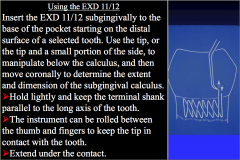
1. start on the distal.
2. keep tip or tip and some of the side in contact with the tooth at all times. 3. terminal shank stays parallel to the long axis of tooth. |
|
|
Describe how you can visualize supra/subgingival plaque clinically.
|
1. good lighting.
2. clean teeth. 3. dry teeth - supra. 4. air stream - sub. |
|
|
What calculus deposits are more difficult to remove? Why?
|
Cementum deposits are harder due to surface irregularities, which allow the calculus to interlock.
|
|
|
what is endotoxins role in a new development in periodontal scaling and root planing?
|

It loosely adheres to the cementum on the root surface, thus making a glassy smooth root surface no longer the goal of root planing.
|
|
|
Define scaling.
|
process by which plaque and calculus are removed from subG/supraG tooth surfaces.
|
|
|
(T/F) Scaling involves calculus removal from both supra and subG surfaces.
|
true
|
|
|
Name the tooth surfaces correlating with each instrument.
-Gracey Currette 3/4? 11/12? 17/18? |
3/4 - M/D Anteriors.
11/12 - posterior Mesial. 17/18 - Posterior Distal. |
|
|
What instruments are the following.
- SIU 17/18 - SIU 13/14 -SIU FW 204 |
- universal currette
- scaler - scaler |
|
|
What are sickle scalers? Which instruments are considered sickle scalers?
|
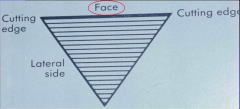
scalers with 2 cutting edges, pointed tip, don't go subG.
SIU 13/14, SIU FW 204 |
|
|
Sickle scalers have __ cutting edges and a ________ tip.
|
2, pointed
|
|
|
Describe how the sickle scalers are used (the stroke).
|
-supragingival calculus.
- short, powerful overlapping scaling strokes in a vertical or oblique direction. |
|
|
Define root planing. What instruments are used?
|
the process by which residual embedded calculus and portions of cementum are removed from the roots to produce a smooth, hard, clean surface.
curettes. |
|
|
(T/F) Fine diamonds and finishing burs are more effective than hand instruments in root planing.
|
True, used during surgical flap reflection.
|
|
|
Cementum on the coronal half of the root is ___-____ um thick, and is readily removed with root planing.
|
16-60, about the size of human hair.
|
|
|
Describe root planing as compared to scaling.
|
- less pressure
- more rapid longer strokes - multidirectional - subG |
|
|
Why would it be a good idea to wait to do extensive root planing?
|
Because the tissue response would tell you where more work would need to be done, avoiding over instrumentation.
|
|
|
The universal curette has ___ cutting edges that are __ degrees from the terminal shank.
|
2, 90.
|
|
|
(T/F) The universal curette can be used efficiently in any type of pocket.
|
False, cannot reach the depths of deeper pockets.
|
|
|
What are some options for using the universal curette? When would you flip it?
|

flip when moving from the mesial to the distal on anterior teeth, on posterior teeth you can use only one end.
|
|
|
How many degrees is the cutting angle from the shank in the gracey curette?
|
70 degrees
|
|
|
What is the difference between the three gracey curettes?
|
The design of the shank differs, the blades are the same on each.
|
|
|
How do the gracey curettes differ from the universal curette?
|
Gracey curettes have a curved blade and are OFFSET at 70 degrees. Universals are straight and have a 90 degree angle.
|
|
|
How does the terminal shank of the Gracey 11/12 differ from the Gracey 17/18?
|
11/12 - has a double turn on the shank, inclined anteriorly
17/18 - long terminal shank |
|
|
What are the four options for anesthesia for SRP?
|
1. none
2. topical 3. local 4. Oraquix |
|
|
Oraquix is a mix of which two topical gels? How long can anesthesia be expected to last?
|
Lidocaine and prilocaine. 20 mins.
|
|
|
______ _______ works well when trying to remove material and clean the instruments during SRP.
|
moist gauze.
|
|
|
What are some factors that limit the effectiveness of SRP?
|

see above
|
|
|
Which teeth can be problematic for SRP simply by there anatomical features?
|
Maxillary bicuspids and there medial concavities.
|
|
|
What are the favorite spots for calculus to reside in?
|
In concavities and just below the CEJ.
|
|
|
What are the four advantages of hand instrumentation?
|
1. greater control
2. increased tactile sensitivity 3. area specific designs for access/adaptability 4. quiet, don't need h2o, don't vibrate. |
|
|
To employ good adaptation, the _____ ____ of the working end of the instrument must stay in contact with the tooth.
|
Lower 1/3
|
|
|
To avoid tissue damage which part of the instrument must always stay in contact with the tooth?
|
the toe.
|
|
|
Define angulation in terms of SRP.
|
It is the angle between the face of the bladed instrument and the tooth surface.
|
|
|
Which angulation is good for insertion of a bladed instrument into the sulcus?
|
0 degrees.
|
|
|
what is a good angulation for SRP procedures?
|
70 degrees.
|
|
|
Before lateral and coronal pressure is applied, what should be established? Does S or RP need more pressure?
|
finger rest and instrument control. Scaling.
|
|
|
What are the three stroke directions?
|
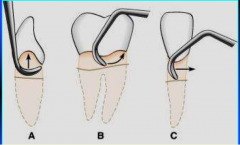
1. vertical
2. oblique 3. horizontal |
|
|
The distance between the apical edge of the calculus and the bottom of the pocket ranges between __ and __ mm.
|
.2-1mm
|
|
|
Calculus deposits are best removed using ______ strokes that ____.
|
multiple, overlap
|
|
|
Describe the process of subG scaling with a curette. Remember to mention angulations.
|
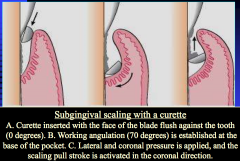
see above
|
|
|
Use the (largest/smallest) instrument that works well.
|
largest.
|
|
|
Should you root plane exposed root surfaces due to recession?
|
No, it will cause sensitivity and supra gingival areas can be kept clean by the patient.
|
|
|
Which two ways are the best to check for sub/supragingival calculus after SRP?
|
Supra- air dry teeth.
Sub- EXD 11-12. |
|
|
Use the EXD 11/12 to determine the _____ and _____ of the calculus.
|
extent and location.
|
|
|
What are two ways to check the effectiveness of scaling and root planing several weeks after the procedure?
|
Probing depths and tissue response.
|
|
|
Describe the modified pen grasp, what fingers go where?
|
- the pad of the middle digit rests on the shank
- ring finger acts as finger rest - thumb is b/w the middle digit and first finger |
|
|
What are the three types of finger rest? Describe them.
|
1. conventional - rest on adjacent tooth, middle digit and ring finger are touching (max control).
2. cross arch - opposite side of same arch. 3. opposite arch - opposing arch rest. |
|
|
The mirror can provide these three things.
|
Visibility, illumination, retraction.
|
|
|
What are two ways to examine the sharpness of a blade?
|
1. examine in strong light, a dull edge reflects light
2. test on a plastic stick or on the tooth surface, a sharp edge will "bite" |
|
|
Which two sharpening stones are available in the SIU clinic?
|
Ceramic and India stones. India stones are much more abrasive.
|
|
|
Describe the sharpening procedure. Remember important angles.
|
Hold the stones at one o'clock position, the universal curette and the sickle scalers will sharpen at the 12 o'clock position, while the gracey curettes will sharpen at the 11 o'clock position.
|
|
|
A properly shaped curette maintains a __ to __ degree angle between the face and the lateral surface.
|
70-80.
|
|
|
(T/F) Sharpening the face of the curette will help keep the sharpening edge from getting dull.
|
False, never sharpen the face.
|
|
|
What are the five basic scaling instruments?
|
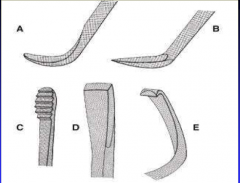
1. curette
2. scaler 3. file 4. chisel 5 hoe |
|
|
What is the difference between the after five curette and the universal curette? what was it designed for?
|
The difference is the length of the terminal shank, its 3 mm longer for a total of 5 mm in length. It was designed to scale and root plane deeper pockets.
|
|
|
What are implacare instruments?
|
They are implant peril instruments with a stainless steel handle with plastic tips.
|
|
|
What are diamond fils good for?
|
Removing the cementum and dentin under a furcation.
|
|
|
Perioscopy technology is used for?
|
visualization of the subG tooth surface.
|

